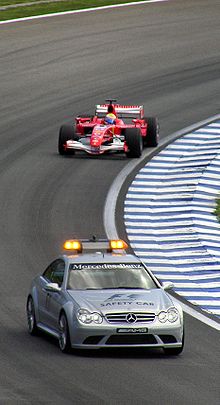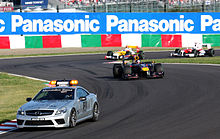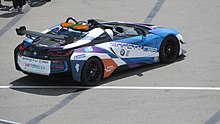Safety car
This situation may provide a strategic advantage since any scheduled refueling, tire change or maintenance may be carried out while other competitors are lapping at lower speed, and the drivers who pit then simply rejoin a queue of cars all running together.In Formula One if an accident or inclement weather (typically, heavy rain) prevents normal racing from continuing safely, the Race Director will call for a "safety car" period, which would see marshals wave yellow flags and hold "SC" boards, pending the car in question entering the track.When the safety car is ready to leave the circuit, it will turn off its orange lights to indicate that it will enter the pit lane at the end of the lap.Drivers must continue in formation until they cross the first safety car line, where circuit green lights and flags will indicate they are free to race again.[4] The safety car must maintain a reasonable speed so as to ensure that the competitors' tyres are as close as possible to operating temperature and their engines do not overheat.The first use of a safety car in Formula One is reported to have taken place at the 1973 Canadian Grand Prix, where a yellow Porsche 914[5][6][7][8] was called for duty following various incidents under treacherous weather conditions.[9] Formula One officially introduced safety cars in 1993, after trials were conducted at both the French and British Grands Prix during the preceding 1992 season.At the same race a year later, Lewis Hamilton failed to notice the red light and slammed into the back of the car of Kimi Räikkönen, who was waiting at the end of the pit lane alongside Robert Kubica.The 2021 Belgian Grand Prix infamously became the shortest race in Formula One World Championship history and the first (and so far only) World Championship Grand Prix in history to be run entirely behind the safety car with no running taking place under green flag conditions, with two full laps completed behind the safety car before the race was red flagged on lap 3 and not restarted thereafter with results taken from the end of lap 1 with Max Verstappen declared the winner of the event and half points awarded to the top 10 classified drivers.The accident panel recommended the implementation of a "virtual safety car", based on the "slow zone" system used in Le Mans racing.[20][21] The system was evolved taking into account drivers' feedback and was officially introduced for the 2015 season following ratification by the World Motor Sport Council (WMSC).[22] The VSC was officially used for the first time, and for a brief period prior to the deployment of the actual safety car, at the 2015 Monaco Grand Prix, following a 30G crash involving Max Verstappen.The system saw its first extended deployment at the 2015 British Grand Prix after Carlos Sainz Jr.'s power unit failed at Club Corner of the Silverstone Circuit.In recent years Chevrolet models have been chosen as the official pace car, owing to the ability for them to be used at both major automobile races at the Speedway (typically Corvette at the 500 and Impala at the 400).During the IndyCar Series season, however, Johnny Rutherford, Sarah Fisher, and Oriol Servià are the normal drivers of the IRL pace car for all events.After much consideration, this rule was added to prevent a situation much like the one that happened in the 1995 Indianapolis 500, when Scott Goodyear passed the pace car going back to green.When race officials are ready to open pit lane, a green light will come on in the rear window of the safety car.Drivers exceeding that speed on pit road will be penalized, typically a "drive-through" or "stop and go" penalty, costing them valuable track position.[27] During a reconnaissance lap, a 2024 Aston Martin Vantage safety car spun out and crashed heavily at the Alboreto corner of the Monza Circuit on the Thursday of the 2024 Italian Grand Prix.[28] The high amount of caution laps during the 2023 IndyCar Monterey Grand Prix resulted in extended use of the Honda Civic pace car.[29] During the opening pace laps of the 2018 Chevrolet Detroit Grand Prix IndyCar race (the second race of a doubleheader weekend at the Belle Isle street circuit), a 2019 Chevrolet Corvette ZR1 pace car leading the field and being driven by General Motors executive Mark Reuss lost control and crashed head-on into the left-hand retaining wall coming out of the exit of turn two of the track, shortly after leaving pit road.[32] Sparks were seen emanating from Montoya's car right before its hard collision with the jet dryer trailer and left driver's side of the truck.The front running LMPs slowed down but some of the GT cars could not react fast enough, resulting in collisions and heavy damage to all three GTE Pro class Porsches which caused them to retire.A succession of first-lap accidents caused the safety car to be placed on standby, with yellow flags waving on the start-finish section of the track.Race leader Franz Engstler came through the kink on the start-finish straight and was unable to avoid hitting the side of the pace car.[41] The pace car of the 1971 Indianapolis 500, an orange Dodge Challenger driven by local auto dealer Eldon Palmer, crashed at the start of the race.
















Experimental Safety VehicleMercedes-Benz SLKDeutsche Tourenwagen MastersGoodwood Festival of Speedmotorsportracetrackmarshalsoperating temperaturered flagIndianapolis 500Superleague FormulaSilverstone CircuitFelipe MassaMercedes-Benz CLK 63 AMG2006 Brazilian Grand PrixFormula Oneyellow flagsBernd Mayländerlight bar1973 Canadian Grand PrixPorsche 914FrenchBritishLamborghini CountachMonaco Grand PrixLamborghini Diablo1995 Canadian Grand PrixFiat Tempra1993 Brazilian Grand PrixOpel Vectra1994 San Marino Grand PrixMercedes-BenzAston MartinBahrain Grand Prix2008 Singapore Grand PrixNelson Piquet, Jr.Fernando Alonsointentional crashJuan Pablo Montoya2005 Canadian Grand PrixGiancarlo Fisichella2007 Canadian Grand Prixthe same race a year laterLewis HamiltonKimi RäikkönenRobert Kubica2021 Belgian Grand Prixgreen flagMax Verstappen2021 Abu Dhabi Grand PrixMercedes-AMG GT R2014 Japanese Grand Prix2015 Malaysian Grand Prix2021 Austrian Grand PrixAston Martin Vantage2024 Belgian Grand PrixPorsche 9111976 Monaco Grand Prix1983 Monaco Grand Prix1993 British Grand PrixHonda Prelude1994 Japanese Grand PrixPorsche 911 GT21995 Belgian Grand PrixRenault Clio1996 Argentine Grand PrixMercedes-Benz CL 55 AMGMercedes-Benz SL 55 AMGMercedes-Benz CLK 55 AMGMercedes-Benz SLS AMGJules BianchiWorld Motor Sport Council2015 Monaco Grand Prix2015 British Grand PrixCarlos Sainz Jr.BMW i8plug-in hybridFormula EMini ElectricJean-Éric VergneAntónio Félix da Costa2019 Rome ePrixseason 6 of Formula E2021 Rome ePrixPorsche TaycanIndianapolis 500 pace carsChevrolet Camaro1993 Indianapolis 500Indy 500Indianapolis Motor SpeedwayStoddard-DaytonCarl G. FisherChevroletPontiac Trans AmChevrolet CorvetteOldsmobile CutlassFord Mustang2007 Indianapolis 500Johnny RutherfordSarah FisherOriol Serviàdebriscollision1995 Indianapolis 500Scott GoodyearLucky dogNASCAR Cup SeriesPontiac Grand PrixNASCARToyota CamryDodge ChallengerTruck SeriesChevrolet SilveradoRam 1500Toyota Tundrawarm-up laps2011 Daytona 500Brett BodineCup SeriesElmo LangleyJay LenoRichard HammondLuke WilsonRob GronkowskiGuy Fieribeneficiary rule